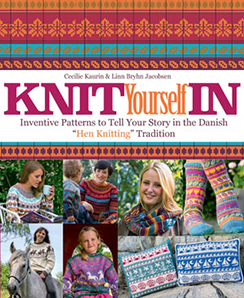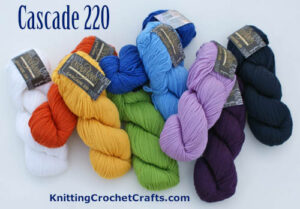Would you be interested in customizing or designing your own colorful knitting projects? If so, you’re likely to be inspired by a book called Knit Yourself In: Inventive Patterns to Tell Your Story in the Danish “Hen Knitting” Tradition. This book presents you with bunches of different customizable knitting patterns for a variety of projects including sweaters, socks and mittens, all of which incorporate colorful pictorial and abstract charted motifs designed in striped panels.
What You Need to Know About This Knitting Pattern Book:

Authors: Cecilie Kaurin and Linn Bryhn Jacobsen
Publisher: Trafalgar Square Books
Copyright Date: This is the English language edition of the book with a copyright date of 2015. The book was originally published in Norwegian in 2014.
ISBN 13: 978-1-57076-723-4
Book Format: This is a hardcover, spiral-bound book, which is the holy grail of craft book formats because it will stay open easily as you knit from it. Hooraaayyyy!!
Number of Pages: 139
Cover Price: $24.95 US dollars — and entirely worth it, although you’ll probably get a great discount if you buy from one of the retailers I’ve linked to at the end of this book review.
The Premise of This Book:
This book exists for two purposes:
- Encouraging you to personalize your knitting projects;
- Giving you knitting charts and patterns that will help you get started with your customizations.
The authors of the book are not breaking new ground with their book concept; they are drawing from a tradition known as “hen knitting” that is apparently well-known in Scandinavian countries, although it was a new idea to this well-traveled American knitter. This book includes some brief information about hen knitting and its originator, Kirsten Hofstätter. So before I even picked up my knitting needles, I learned bunches of interesting history from this book — which I enjoyed immensely.
Knitting Projects Included in This Book:
- Karpe Diem knit sweater for children
- Karpe Diem knit sweater for adults
- Animals in Africa knit sweater for children ages 1-4 years old
- Women’s Garden sweater with round yoke
- Tulip knitted socks
- Sea sweater with round yoke
- Little sailor maritime baby sweater sized for little ones ages 6 months – 12 months
- Maritime pillow cover with anchors; another variation substitutes sailboats for the anchors, so you could make 2 related but different cushions using this pattern.
- Horse sweater
- Dog sweater — bunches of different dog motifs are charted out, so you can take your pick which one you want to use: Labrador retriever, terrier, dachshund or others.
- Children’s dog sweater
- Northern Norway sweater
- Northern Norway mittens
- Autumn sweater
- Forest pillow cover with fairies
- Forest pillow cover with deer
- Children’s barnyard sweater sized for kids ages 2-6 years old
- Princess sweater for girls ages 2-6
- Prince sweater for boys ages 2-6
- Café sweater
- Hat with leftover yarns
- Inca scarf
- Clothes hanger for hen knitting
Other Contents of This Book:
The authors give you an alphabet chart to use for monogramming or knitting full names into your projects. In addition to the patterns, they also include helpful information about designing your own projects; they’ve also included tips and helpful information on other topics relating to the technical aspects of creating your projects such as gauge, blocking and more.
The Best Things About This Book
Knit Yourself In is one of the most exciting and inspiring knitting books I’ve come across in a long time. Every detail about the book is lovely, from the spiral binding to the wonderful photographs to the vivid color charts.
The projects in this book are remarkably colorful, interesting, eye-catching and fun.
I’m not the only one who thinks so. My one-year-old daughter literally squealed with delight when she saw the colorful “Animals in Africa” sweater featuring giraffes, crocodiles and other exotic animals.
These authors have exceptional color sense, which really enhances the design work. These projects are all colored beautifully, and the colorways are usable exactly as presented in the book. Of course, you can re-color them into your own favorite colors if you’d like.
There’s a wide variety of design themes represented, all of which have mass appeal — animals, nautical motifs, fairies, flowers, food, geometrics and more.
The book is written in an encouraging, supportive voice that’s likely to empower you to try interesting things with your knitting that you wouldn’t have thought of otherwise.
The photographs in the book will make you feel as if you’ve been transported to Norway — so if you could use a good vacation in addition to some new knitting patterns, this book is an outstanding investment from both the crafting and armchair traveling perspectives. After reading this book and seeing its spectacular photos, I’ve added Norway to my bucket list of future travel destinations.
One other noteworthy thing worth mentioning about the photos in this book: You’ll find multiple clear photos of most projects; for a majority of the wearable projects, you’ll find both a photo of the garment being worn by a live human model plus a photograph of the project either laid flat on the ground or hung on a hanger. There are close-ups here and there showing various details.
Things to Be Aware of Before You Buy This Book
You’re pretty well covered with lots of different pictures of most of the projects — however, there are no schematics with measurements included in the book.
There’s a reason you don’t often see such innovative combinations of multiple patterns and colorwork used together in the same knitting project: the math can be enough to drive a pattern designer bonkers. Therein lies the only downside to this book that I’ve found so far: The math doesn’t always work out right for every pattern motif in every project in every size. So, for example, you might find places where you’ll end up with half a crocodile motif in one spot on your sweater or a headless giraffe in another spot.
The authors of the book have done their best to avoid this problem where the larger and more prominent motifs are concerned. However, they don’t see this as being a problem for smaller, less prominent motifs. For starters, their goal is to get you working on customizing your own patterns. So if you’re the type of perfectionist who would be dissatisfied with having partial motifs present in your projects, they’d likely encourage you to redesign the motifs or the spacing between them to your own satisfaction so you avoid those sorts of problems completely. But they’re also quick to encourage you to put any half-motifs that pop up in the side seams instead of the front of your project, and not worry about it too much if a few knitted motifs are incomplete or your panels are not totally symmetrical.
Conclusion
This book and its contents are absolutely charming. I’m delighted to recommend Knit Yourself In to other crafters, particularly knitters who are eager to get started with customizing their knitting projects to make them unique and one-of-a-kind.
Where to Buy This Book:
Similar Craft Pattern Books and Related Resources

- Handknits From Rauma, Norway: Scandinavian Knitting Pattern Designs
- Selbu Mittens Book Review: Get Mitten Knitting Patterns and History
- Norwegian Sweaters & Jackets Knitting Pattern Book
- Take a look at the Alterknit Stitch Dictionary, a book that would be an ideal companion to Knit Yourself In. The Alterknit Stitch Dictionary features charts for fun stranded colorwork patterns — sheep, owls, bunches of geometrics and more.
- Check out Jorid Linvik’s Big Book of Knitted Mittens to find more lovely Scandinavian knitting patterns.
Learn More About Knitting

- Click here to check out our beginner’s guide to knitting needles.
- Click here to find our picks for the best knitting books of 2023 and beyond.
- Find the Most Important Knitting Abbreviations You Need to Know
- Discover the Best Yarn for Knitting and Crocheting
Posted By: Amy Solovay
This page was last updated on 8-4-2023.